Hair care for men and women: Victorian - 1950s
This page describes the different ways that men and women used to care for their hair. Uses of soap, shampoos, dry shampoos and vinegar for washing and rinsing hair are explored, as are the different styles of brushes, combs and lotions for keeping hair tidy. Brylcreem for men is included.
____
By the webmaster based on discussions with older people and research in museums
Washing hair
Frequency of washing hair
Hair-washing needed to be organised well in advance to heat enough water - either using the old copper or - in my childhood - the coal-fired boiler. It was normally on Fridays - when it happened - to coincide with bath-night to make efficient use of the hot water, but excuses were often made for it not to happen regularly.
Why washing hairing-washing was so unpleasant
As a child growing up in the 1940s, I dreaded my mother washing my hair. This was because she had the old-idea that if you got wet, "the dampness went into you and gave you a cold". So my hair was never allowed to dry naturally; it was rubbed and rubbed with a towel until it was dry. Can you imagine the tangles! To make matters worse, my hair was long. (It was in plaits during the day.)
Then when my mother had decided that the tangled mass was dry, she would drag a comb through it - which tore it out. No wonder I made every excuse possible to skip hair-washing.
Later my aunt told me not to bother to dry my hair with a towel, but just to comb it while it was still wet, starting from the ends away from the roots and then progressively combing from a little bit further up. I have never looked back.
Soap or shampoo and what else?
My mother used plain soap for washing my hair, but in my teens I used shampoo. Shampoos were not common until the late 1950s, although one called Drene had existed in the 1930s. My father washed his hair with soap all this life right up until he died in the early 1970s.
How we made hair shine
contributed by Anne Jameson, a childhood memory
In my home, to make hair shine after washing, it was rinsed with vinegar and rain water from the water-butt outside.
Dry shampoo
A powder known as a dry shampoo was available for when anyone didn't or couldn't wash their hair. I did try it once. It was brushed into the hair where it absorbed the greasiness. It did nothing to cleanse the scalp, and as it never brushed out properly, it took the shine out of the hair. At the time, it was widely thought that women should not wash their hair while they had a period.
Hair brushes and combs
Brushing hair was more common than combing. As this was before plastics became commonplace.
Brushes were bristle, set into wood which was widely available and cheap. Numerous small farms reared pigs for food, making their bristles a by-product.
Nit combs
Nits and lice in hair were not uncommon, and even as recently as the 1940s, I remember the nit-nurse coming to school to check every child's hair for them. For treatment, there was a powder, but also a special nit comb which had its teeth very close together to drag out the nits as it combed. Most families had one, as mine did, but it was probably inherited as I never saw it used.
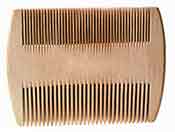
Wooden nit comb for combing nits and lice out of hair
Brushing hair for women and girls
For women and girls, hair brushing routines were widely favoured and usually rigorously followed. Or perhaps I should say that when we fell short of the designated 100 strokes a day, we felt guilty. It did get rid of some of the dust and it certainly made hair shine but it also encouraged greasiness.
The sort of brushes looked hardly different from the wood and bristle ones sold today in that they had a handle, but wealthy people had tortoiseshell.
Brushing hair for men and boys
Men's and boys' hair brushes were different from women's and girls' brushes in that they didn't have handles. I don't know if there was a practical reason for this or whether it was just fashion. These hair brushes came in pairs. The body of the brushes were held, one in each hand, and both hands were used at the same time for what was really merely styling.
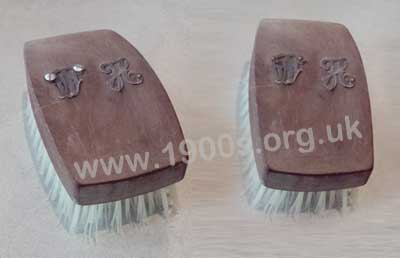
Pair of men's hairbrushes, with the owner's initials secured onto the back surface. Photo courtesy of Bill Hogg. The initials are WH in rather old-style lettering, and are those of his father of the same name, William Hogg.
For how women and girls curled their hair and how the tools available affected hairstyles see the above menu or use the search box on the home page. It would not have been acceptable for men to curl their hair.
Brylcreem lotion for men's hair
I never knew anything of the 100 brush strokes a day for men and boys or of brushing causing their greasy hair. Any greasiness due to brushing would not have noticed anyway because it was fashion for men and boys' hair to be smarmed down with a grease or lotion called Brylcreem. 'Smarmed down' is my description; they would have called it being groomed or tidy.
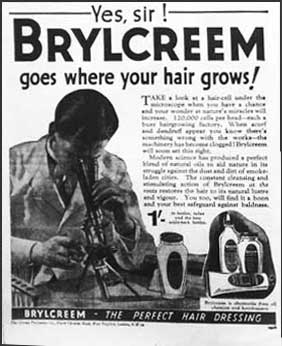
1939 advertisement for Brylcreem. A jar cost one shilling, 5p in today's money
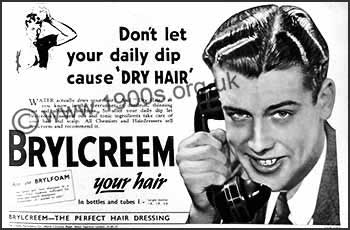
The Brylcreem blurb reads:
'Water actually dries your hair! And Dry Hair, as
you know, is the cause
of dandruff, thinning
hair and ultimate baldness. So after your daily dip let
forerunner
Brylcreem's natural oils and tonic ingredients take care of
your hair and scalp. All Chemists and Hairdressers sell
Brylcreem and recommend it.
Note how the ads imply that users of Brylcreem have come up in the world. Microscopes and telephones were not for working class men at that time.
Rather than show you yet another Brylcreem ad, here are some cartoon extracts from one:

BRYLCREEM! ... Jack can't do without it. I'll put a bottle in his Christmas stocking.
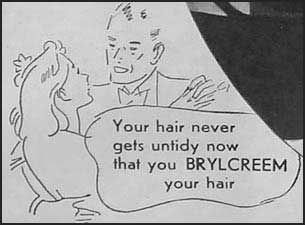
Your hair never gets untidy now that you BRYLCREEM your hair.
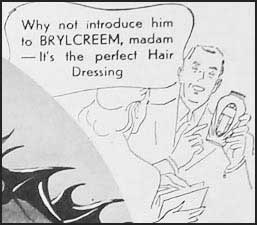
Why not introduce him to BRYLCREEM, madam - it's the perfect Hair Dressing.
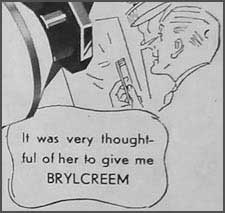
It was very thoughtful of her to give me BRYLCREEM.
Text from a full-page ad
If he does use Brylcreem, he'll welcome another jar or tube because Brylcreem is essential for that neat, well-groomed appearance. Brylcreem is the most popular hair dressing in the world and it keeps a man's hair strong and healthy all the year round. Put him down for Brylcreem!
If he doesn't use Brylcreem, how grateful he will he to be introduced to the most perfect hair dressing you can buy. He'll soon discover that Brylcreem does away with that 'gummed' appearance; that its pure, natural oils penetrate deep into his scalp, removing the cause of dandruff, restoring the natural gloss of his hair.
Brylcreem ought to have sold well with all that advertising - and it did! My father always had a jar in the bathroom.
To prevent easy-chairs becoming greasy from men's hair, all households used chairbacks which could be washed. There is a photo of a chairback on the page about general furnishings.
| sources | webmaster | contact |
Text and images are copyright
If you can add anything to this page or provide a photo, please contact me.



